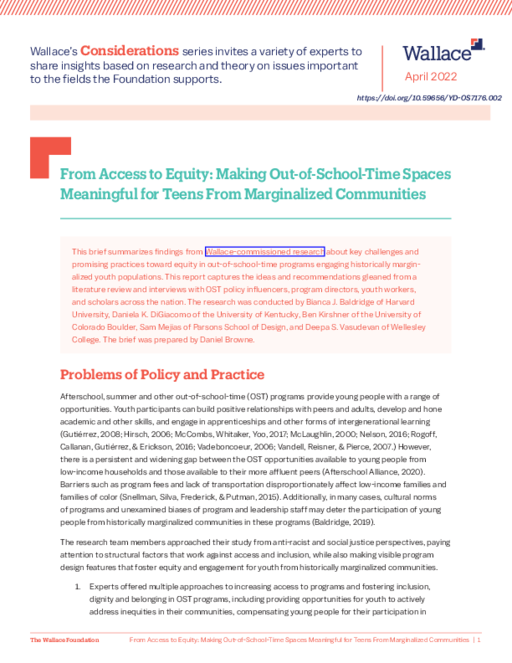
Breadcrumb
- Wallace
- Reports
- From Access To Equity Making Out...
From Access to Equity
Making Out-of-School-Time Spaces Meaningful for Teens From Marginalized Communities

- Author(s)
- Daniel Browne
- Publisher(s)
- The Wallace Foundation
Summary
How we did this
The researchers carried out their study with a social justice perspective. They conducted a review of pertinent research from the past 20 years. They interviewed almost 60 experts in out-of-school-time research, policy, and practice. They held seven focus groups with professionals in the field. And they launched a research project about youth perspectives on program equity and access. This was carried out by high school and college students.
This brief looks at obstacles out-of-school-time programs face in achieving equity for youth participants and youth workers. It also looks at solutions.
The paper is based on ideas from a Wallace-commissioned study led by Bianca Baldridge, a professor and former youth worker, now at Harvard University. Baldridge examines out-of-school-time programming and the intersection of race, class, and power. The brief is part of Wallace's Considerations series, in which the foundation invites leading scholars and other experts to share insights based on research and theory.
Two Categories of Findings
The research team members divided their major conclusions into two categories: youth and youth-field workers.
Supporting youth
The team found that many out-of-school-time programs seek to address inequity, but they also can perpetuate a “deficit-oriented” approach. That means that Black, Latinx, Indigenous, Asian American, and Pacific Islander youth are seen as “at risk” and in need of being “fixed.”
The alternative is a “strengths-based, humanizing, and dignity-based approach.”
What would that look like? The research team offers many ideas. Among them are:
- Setting up a network of mentors for program participants and basing it on the young people’s interests and needs
- Shaping staffing and leadership that better reflect the racial and cultural backgrounds of the young people
- Using language and behavior that counter deficit-based and racist ideas about marginalized youth
- Paying young people to attend so they can fully participate and still financially contribute to their families
Supporting the staff members, youth-field workers
Many out-of-school-time program staffers come from the same backgrounds as program participants.
They have reported experiences of tokenization or marginalization on the job. Also, although they often care deeply about their work, they frequently struggle with remaining in their positions. That's because of low wages, job instability, and other unfavorable working conditions.
A number of steps could change this picture. They include paying youth-field workers a livable wage and offering them a clear pathway to leadership positions.
A role for funders and civic leaders
Funders and civic leaders could help to make out-of-school-time programs more equitable. Steps could include:
- Allowing for multi-year funding so programs can spend more time on things like programming and less time on things like grant writing
- Allocating funding for professional development to help programs make racial and social justice part of their work with young people
The youth perspective
Part of the study involved research by high school and college students. They examined young people’s views of equity in and access to out-of-school-time programs. Another brief summarizes this youth-led research.

Although many OST programs seek to address racism and other forms of inequity, they can simultaneously perpetuate deficit-oriented approaches to engaging racially minoritized youth.
Key Takeaways
- Many out-of-school-time programs seek to address inequity, but they also can perpetuate a “deficit-oriented” approach.
- This can be answered in a variety of ways. Among them are using language and behavior that counter deficit-based and racist ideas.
- Workers in programs can encounter tokenization or marginalization on the job. They also often struggle with remaining in their positions because of low wages, job instability, and other unfavorable working conditions.
- Solutions include paying the workers a livable wage.
Materials & Downloads


What We Don't Know
- What are the experiences, practices, and career paths of out-of-school-time workers?
- How does civic infrastructure–such as transportation and availability of spaces–affect program participation?
- How does participation in out-of-school-time programs affect young people in the long term?

